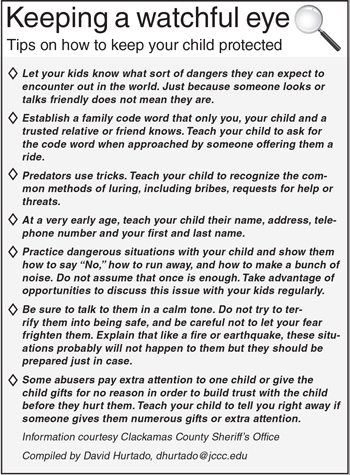By David Hurtado
White with grey hair, a mustache and glasses driving a silver four-door sedan. This was the description a Holy Spirit Catholic School student gave of a man who allegedly tried to abduct her on Feb. 14.
The incident was one of four stranger danger kidnapping incidents reported in the last month in the Johnson County area. Half of them occurred in Overland Park and the other half took place in Shawnee.
 Sara McElhenney, director, Hiersteiner Child Development Center, said children tend to be easy targets due to their trusting nature and their dependence on someone else to care for them.
Sara McElhenney, director, Hiersteiner Child Development Center, said children tend to be easy targets due to their trusting nature and their dependence on someone else to care for them.
“I think anyone who can’t care for themselves, or any human being that isn’t able to manage their own self is at risk,” McElhenney said. “A child just really needs someone to be with them, look after them, care for them and so forth. They are a real easy target from that standpoint.”
Although there have been four attempted kidnapping incidents in recent weeks, Gary Mason, Public Information Officer, Overland Park Police Department (OPPD), said there is nothing to indicate this might become an increasing problem.
“We’ve been fortunate not to have any kids that have been kidnapped,” Mason said. “Our goal with the police and working with the community and school districts is to not have any. […] These kids walking to a school bus stop by themselves in the morning are very good targets for sexual predators out there that are looking for an opportunity to nab a child. Overland Park and Johnson County haven’t had that problem, so we’ve been fortunate.”
However, Mason noted that these recent reports have put some local residents on edge. He said even with one or two reported incidents, people become more hypersensitive to what is going on around the area. Mason said the department has received a few more calls about what he termed as “suspicious activity.”
In determining the appropriate age for children to begin walking to school on their own, McElhenney said a child’s maturity is one of the primary factors to consider.
“I think that is the decision of the family,” she said. “I know kids in elementary school who are quite capable of walking to school on their own, and I know others the same age that probably shouldn’t be walking on their own.
Wendy Dunwiddie, student, said she doesn’t feel like the really needs to watch her kids around their school and neighborhood. She said the most she worries is when they get hit during a basketball game. Dunwiddie has two sons and one daughter.
She said the most she worries is when they get hit during a basketball game. Dunwiddie has two sons and one daughter.
“In terms of them going places, if they go to someone’s house, it’s someone that we’ve already met,” Dunwiddie said. “We usually invite families over so we can get to know them.”
If approached by a stranger, Mason said the best thing kids can do is to not communicate with them, run in the opposite direction, and find an adult they can trust to tell what happened.
In teaching children about stranger safety, Mason said it is possible a child could take the lessons to the extreme and mistrust everyone they don’t know; albeit a remote one. Even so, he said because of the world we live in, it is in the best interest of children to teach and prepare them for what to do if they encounter a dangerous situation.
“When we deal with stranger danger, I think we as a community need to keep an eye out on our children,” Mason said. “If you see kids walking through the neighborhood, keep an eye out for them and make sure nothing happens to them. The best eyewitness we can have if something does happen if the neighborhood in general watches out for these young kids as they are walking to and from school or are just out playing.”
She said the most she worries is when they get hit during a basketball game. Dunwiddie has two sons and one daughter.
“In terms of them going places, if they go to someone’s house, it’s someone that we’ve already met,” Dunwiddie said. “We usually invite families over so we can get to know them.”
If approached by a stranger, Mason said the best thing kids can do is to not communicate with them, run in the opposite direction, and find an adult they can trust to tell what happened.
In teaching children about stranger safety, Mason said it is possible a child could take the lessons to the extreme and mistrust everyone they don’t know; albeit a remote one. Even so, he said because of the world we live in, it is in the best interest of children to teach and prepare them for what to do if they encounter a dangerous situation.
“When we deal with stranger danger, I think we as a community need to keep an eye out on our children,” Mason said. “If you see kids walking through the neighborhood, keep an eye out for them and make sure nothing happens to them. The best eyewitness we can have if something does happen if the neighborhood in general watches out for these young kids as they are walking to and from school or are just out playing.”
Contact David Hurtado, staff reporter, at [email protected].





















